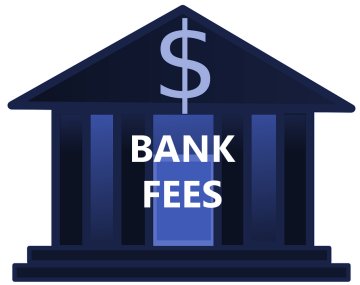How to Save Money on Bank Fees
The US banking industry increased the fees it charges for almost everything a few years ago when the Obama administration got new banking laws changed. If you have noticed that you pay more for your banking services, now you know why. Here are a few lessons I have learned along the way about reducing my banking fees. I hope you can benefit from them.
Eliminate the Monthly Checking Account Charge

Some banks will waive the monthly checking fee if you set up a direct deposit from your checking account into your savings account. If you don’t have a savings account it takes very little time to set one up. But you have to keep at least some money in the savings account. If the bank sees a zero balance in there for a few months they will close the account.
Another way to get a bank to waive the monthly checking fee is to have your paycheck direct deposited into your account. Once the bank sees a regular monthly, bi-monthly, or weekly deposit coming in they will waive the fee. But there is catch: the banks may be looking for a minimum amount on the direct deposit. If you don’t get that much money in any regular paycheck you still have to pay the fee.
The way I have found to get around this is to transfer money into an account with another bank and then to transfer the money myself. I use Paypal but if you cannot wait for your money to pass back and forth (this can take up to a week) you’ll have to gradually save up enough money so that you can do the transfers. You should ask your banker what the minimum amount of money per direct deposit has to be before they’ll waive the fee.
Use Paypal to Avoid Overdraft Fees
If you already have a Paypal account and you have money in it, get a Paypal debit card. There are two benefits to using this debit card.
First, they give you a 1% rebate on all non-debit charges (you have to use it as a credit card).
Second, if your bank account is overdrawn and you have money in Paypal, you can pay a lesser fee by withdrawing money from your Paypal account at an ATM and depositing the cash directly into your bank. So instead of paying a $30-35 overdraft fee you just end up paying $4-8 for the Paypal withdrawal.
Do Not Set Up Recurring Direct Debits
Banks love these direct debits because if you don’t have the money in the account when they go through the banks can charge you overdraft fees. They may pay the debit or not. Either way you still have to pay the overdraft fees, and if the merchant tries to charge you again before you have the money in the account you have to pay the overdraft fee again.
Recurring charges are one of the dumbest things you can set up for a bank account. If you have an emergency, if your employer’s deposit does not go through on time, or if you lose your job you should add at least 1 overdraft charge to every recurring payment you set up through your bank account in your monthly budget until you get back on your feet again.
You may not miss any payments if you manage your money carefully but you should budget for 1 overdraft fee on every recurring direct debit until that debit is cancelled.
Use Your Bank’s Free Bill Pay Services Instead of Direct Debit
Instead of allowing a merchant to direct debit your bank account, use the free bill pay. Banks will print and mail checks for you, often free of charge. By using this service you avoid most overdraft fees because the bank will not make the payment if the money is not in your account. In rare situations they may write a check against money you commit elsewhere.
You have to schedule your bill pay service to make those payments about a week before your due date because the payments really do get mailed out. I avoid doing business with merchants that insist on using direct debits, even for small amounts.
In fact, those small monthly charges are the worst when it comes to paying overdraft fees. A $10-a-month gym membership, for example, can cost you $45 per month if it hits on the wrong date.
Get Cash Back Instead of Using the Store’s ATM Machine
Unless you are very lucky, the retail store that has an ATM machine is probably not associated with your bank. That means if you withdraw cash through the ATM machine you’ll have to pay a non-associated withdrawal fee. These fees can run from $1 to $5.
Instead, use the retailer’s cash back policy to get money when you make a purchase. Be careful not to make a lot of unnecessary purchases just to get cash. Grocery stores are usually the best places to get cash back on a bank debit card. You are already buying things you need and you probably just need pocket money.
If for some reason you need more than $50 cash, either go find your bank’s nearest ATM machine or make several purchases in different stores. In most situations you should not need to withdraw more than $50 if you are using a debit card to purchase things.
Always include these cash back withdrawals in your monthly budgets.